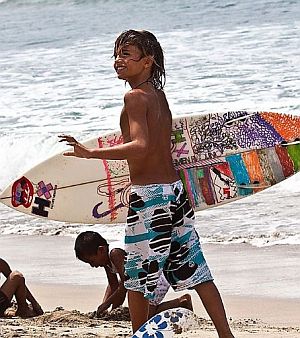The best-known surfing destination on the stretch of coastline that marketers have dubbed Riviera Nayarit is the fishing village of Sayulita, just 25 miles northwest of Puerto Vallarta but still a simple, tranquil beach town (for now — it's growing fast).
The most popular of its two main surf spots is the right break fronting the main beach in the village, which is consistent and ideal for beginners. The faster and less consistent left break on the north side of the river mouth draws mostly locals and expert surfers.
"There's more of a local surfing scene in Sayulita than in other places because other breaks are generally reef breaks outside of town with no people living there," said Geordie Wardman, a Bermudan who relocated to Sayulita for the culture and the good school for his two now-bilingual children as well as for the surfing.
The mix of locals to tourists is about half and half on the right break but mostly locals on the less consistent left break, only about 200 yards away. Generally the locals and the tourists get along well, avoiding the territorial attitude the surf scene is notorious for.
"When the swell is bigger, better surfers expect people there to know what they're doing — there's not a lot of tolerance of tourists going out and cutting people off," he says. "But the town is made by its surf breaks, and it's generally very tolerant. Giving lessons is very much a part of the culture."
Wardman, who writes a Mexico travel blog, also recommends Punta Mita, the Riviera Nayarit's luxury destination, for beginners. The Anclotes break in front of the uber-upscale St. Regis and Four Seasons hotels is a favorite for novices, while Punta Burros on the northern side of Bahía Banderas, which gives a good ride even when waves are small, become a challenge when the swell gets big.
Even Puerto Vallarta itself has some viable surf spots. Other Riviera Nayarit locations with respectable waves are Lo de Marcos and Destiladeras, where waves are reported up to 6 feet.
Matachen Bay
The place where it all began is still going strong, with the legendary break known as Las Islitas, once known as the longest wave in the world. It still has its moments, but it's highly inconsistent and diminished by jetties along the shore.
Zabransky favors San Blas, a peaceful tropical fishing village on the bay that has modest shore and jetty breaks year round. The beach is uncrowded and friendly.
"San Blas is a community, a little town where everyone goes down to the water. There's more of a concentration of people in the water, but then you get to talk about it and sit on the beach and have a beer," he says. He describes some of his experiences there, as well as surfing and traveling in other areas, in his blog.
A time-honored surf spot, Mazatlán offers swells any time of year but its renowned "sick long lefts" (according to Transworld Surf magazine) are most consistent between May and September. The 400-year-old seaport city is hosting the first-ever Quiksilver Clásico Mazatlán, the first event of this size in Mexico, June 1-5 in the Zona Dorada at Playa Camaron, "a reeling left point (reef) break in the heart of Mazatlán's beach and hotel 'Golden Zone'."
Playa Norte, Playa Bruja and Playa Olas Altas (naturally — it translates to "High Waves Beach") are three spots to catch the best waves in Mazatlan. Playa Olas Altas has the added lure of being smack in the middle of Old Mazatlán, the beautifully restored colonial center of the city. Cerritos beach, north of the Marina El Cid, is a little-visited area whose northern tip, called Playa Bruja, is manna for surfers (but be on the lookout for jellyfish during spring and summer months). Another very good spot is on Isla de las Piedras, an ejido (cooperative)-owned ecological playground about 15 miles south of town.
Baja California Sur
The Baja peninsula's proximity has made it hugely popular with U.S. West Coast surfers. For those spooked by the drug-related violence near the border, Baja California Sur is a safe haven endowed with world-class surf breaks. If you're the all-inclusive, margarita-in-a-beach-chair type, head for Los Cabos, where being at the tip of the peninsula means epic swells from one direction or another virtually any time of year. Even backpacker types have to admire the prodigious waves barreling in from May to November at Sippers and Old Mans, side-by-side breaks about 20 minutes outside of Cabo proper but equipped with the same amenities.
To tone down the tourist clamor, head for quieter, palpably Mexican San Jose del Cabo, home of the Estuary — a right and left beachbreak that gets even more waves. But for a whole other level of relaxation, try subued artist/expat/surfer enclave of Todos Santos, about 90 minutes up the Cape's west coast. It's dotted with consistent surf breaks, including Playa Cerritos, San Pedrito, in the community of Pescadero and Playa La Pastora, about 5 miles north of town. These, too, can become gargantuan when storms come through.
Former Chronicle travel editor Christine Delsol is the author of "Pauline Frommer's Cancún & the Yucatán" and contributor to "Frommer's Mexico 2011" and "Frommer's Cancún & the Yucatán 2011.


